Tibial plateau fracture surgery
|
Tibial plateau fracture Microchapters |
|
Diagnosis |
|---|
|
Treatment |
|
Case Studies |
|
Tibial plateau fracture surgery On the Web |
|
American Roentgen Ray Society Images of Tibial plateau fracture surgery |
|
Risk calculators and risk factors for Tibial plateau fracture surgery |
Editor-In-Chief: C. Michael Gibson, M.S., M.D. [1]; Associate Editor(s)-in-Chief: Rohan A. Bhimani, M.B.B.S., D.N.B., M.Ch.[2]
Overview
Surgery is the mainstay of treatment for tibial plateau fractures. Fractures presenting with vascular injury as well as fracture dislocations should be managed emergently. The principles of definitive fixation for tibial plateau fractures include restoration of articular surface and mechanical axis alignment. The fracture fixation depends on fracture pattern. Approach for the fracture depends on fracture pattern and type of implant preferred by the surgeon. The implant commonly used include percutaneous cancellous and raft screws, locking plate, anti-glide plate, and external fixators including Ilizarov ring fixator.
Surgery
Surgery is the mainstay of treatment for tibial plateau fractures.
Indications
- Indications for fixation of tibial plateau fractures include:[1][2]
- Open fractures
- Compartment syndrome
- Vascular injury
- Lateral plateau fractures with
- Articular step of > 3 mm
- Condylar widening > 5 mm
- Coronal plane instability
- Displaced medial plateau fractures
- Bicondylar fractures
Initial Management
- Fractures presenting with vascular injury as well as fracture dislocations should be managed emergently.
- Compartment syndrome is an emergency which requires immediate four compartment fasciotomy regardless of the planned definitive management.
- Open fractures with gross contamination also warrant emergent management.
Principles of definitive fixation for tibial plateau fractures
- The principles of definitive fixation for tibial plateau fractures include:[3]
- Restoration of articular surface and mechanical axis alignment.
- Balanced fixation using appropriate hardware.
- Operate only when soft tissues conditions are appropriate such as skin wrinkling and minimal blisters.
- Minimally invasive technique should be preferred.
Fixation Techniques
The fracture fixation depends on fracture pattern.
Schatzker I Fractures
- The type I fractures carry the best prognosis.
Percutaneous Screw Fixation
- Partially threaded cancellous screws are usually used.
- This is followed by early range of motion.
Locking Plate
- They offer no biomechanical advantage.
- They do permit earlier weight bearing.
Schatzker II and III fractures
- The type II fractures pattern are common and associated with an articular step off that needs to be reduced.[4]
- The type III fractures pattern usually have only an articular step off which is not easily appreciated on x-rays.[5]
Approach
- The incision is taken anterolaterally with elevation of the iliotibial band and tibialis anterior in continuity of Gerdy’s tubercle and a sub-meniscal approach to the articular surface.[6][7]
- This is followed by elevation of the articular surface, reduction of the condylar split if present.
- Finally fill the metaphyseal defect with bone graft or bone cement such as calcium phosphate cement.
Implants
- The implants used for fixation include:[8]
- Subchondral raft of screws
- Antiglide plate
- Peri-articular fixed angle locking plate
- Rim plate to stabilize posterolateral fractures
Other Options
Arthroscopic-Assisted Reduction and Internal Fixation
- Studies have shown that patients treated with this technique return to sport a lot sooner than those treated by standard open reduction and internal fixation.[9][10]
Balloon guided Inflation Tibioplasty
- It is a relatively new technique.
- In this technique, calcium phosphate or Poly methyl methacrylate (PMMA) -loaded balloon is used to indirectly reduce the articular surface under fluoroscopic guidance.[11]
Schatzker IV Fracture
- The medial condyle fracture is often has a posteromedial component. [12][13]
- Percutaneous and minimally invasive open techniques may be used for more simple fracture patterns such as those involving the anteromedial condyle.
Implants
- Locking plate
- Buttress Plate
- Percutaneous cancellous and raft screws
Schatzker V and VI
- They are complex comminuted fractures often due to high-energy.[14]
- There is often require staged management of these fractures.
- Complication rates have been reported to be as high as 30% with these fracture patterns.
Approach
- Combined medial and lateral incisions are taken to address articular disruption.[15][16]
- Midline incisions though commonly not used, is preferred by some surgeons to cater for future need for conversion to arthroplasty to avoid extensive soft tissue injury and de-vascularise fracture fragments.
- The use of limited internal fixation and definitive external fixation is supported by some surgeons as it minimizes soft tissue disruption, avoid complications and allow fracture union with decreased infection rates.
Implants
- Locking plate
- Antiglide Plate
- Percutaneous screws
- External Fixator
- Ilizarov Fixator
Postoperative Care
- There is a risk of potential disability in form of chronic flexion contracture post-operatively.[17]
- Patients are placed in a hinged knee brace which is locked in extension.
- A padded bump in form of cotton roll is placed under the heel during the hospital stay and at home after discharge to maximize knee extension and decrease the chances of bed sores.
Complications
- The complications of the operative interventions include:[18][19]
- Compartment syndrome
- Vascular injuries
- Swelling and wound-healing problems
- Infections
- Deep vein thrombosis
- Nerve injuries
- Knee stiffness
- Knee instability
- Angular deformities
- Late collapse
- Malunion
- Osteoarthrosis
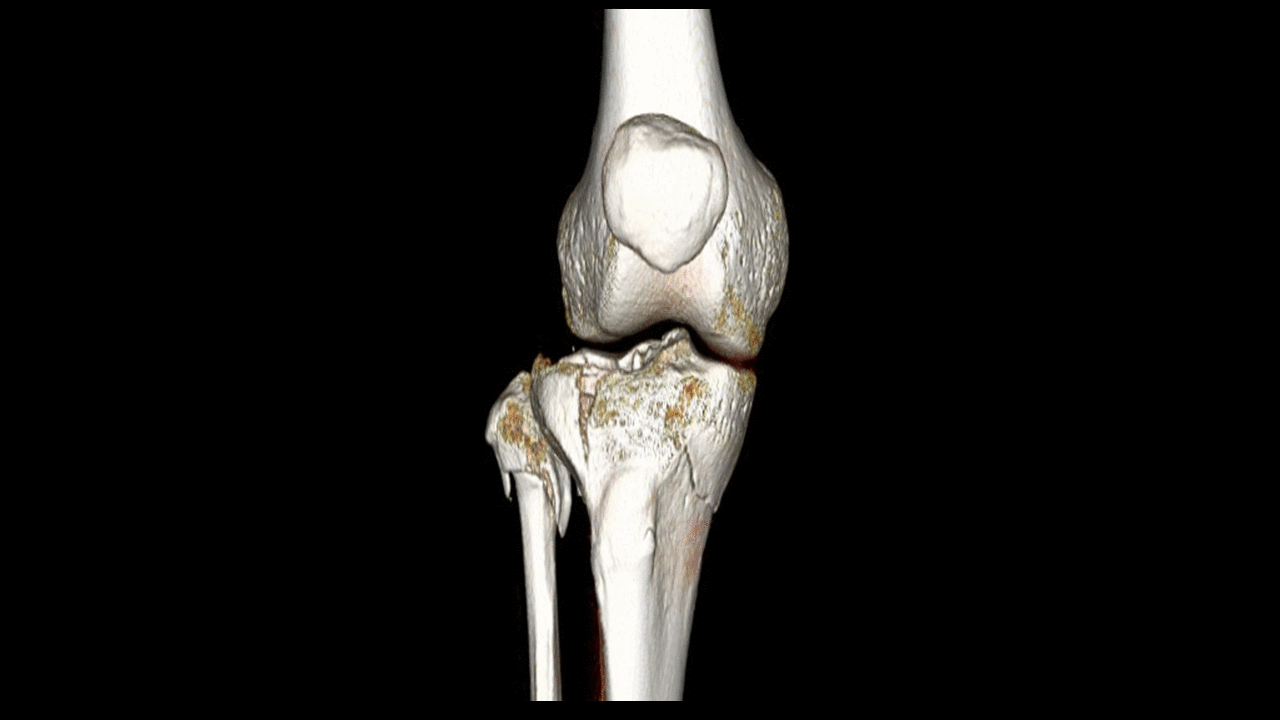 |
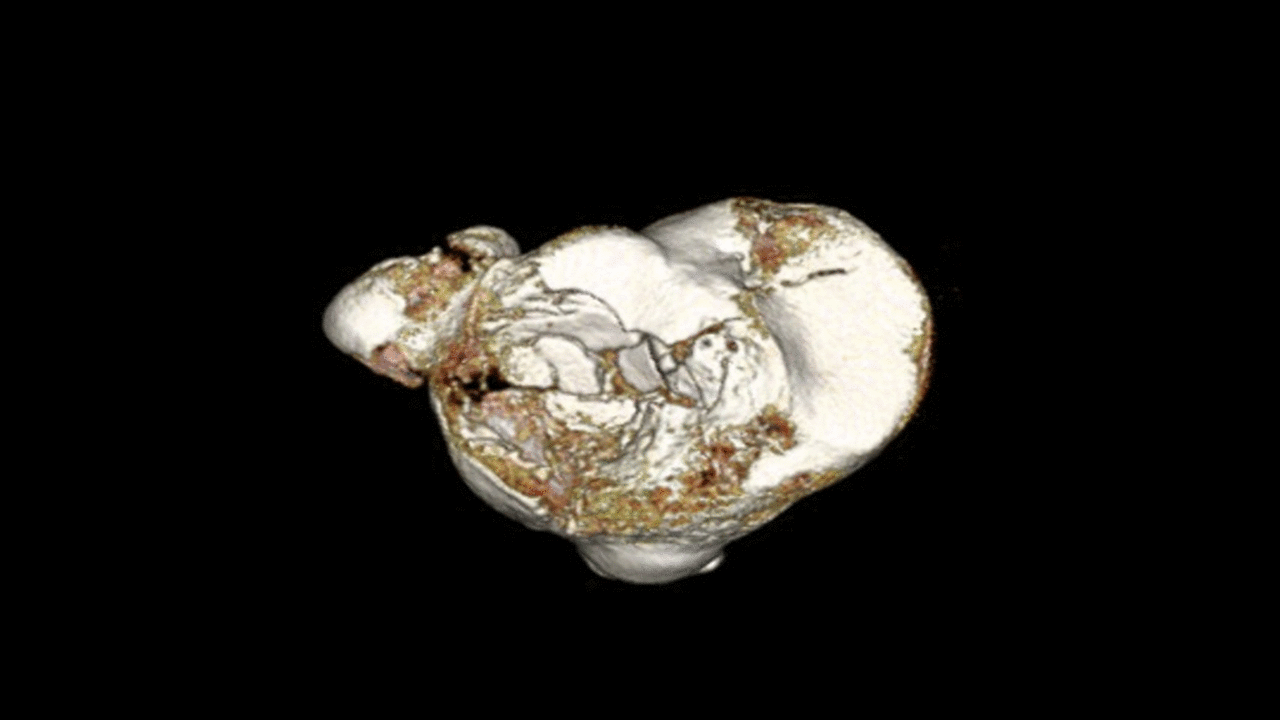 |
 |
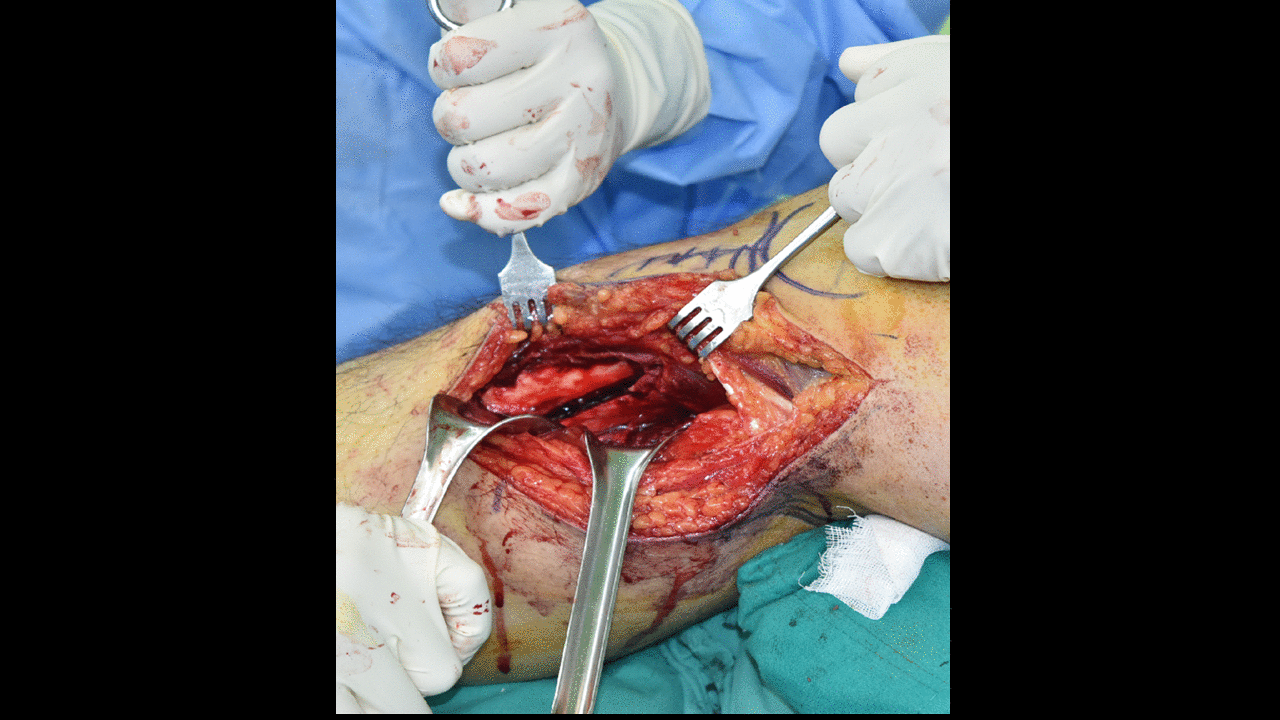 |
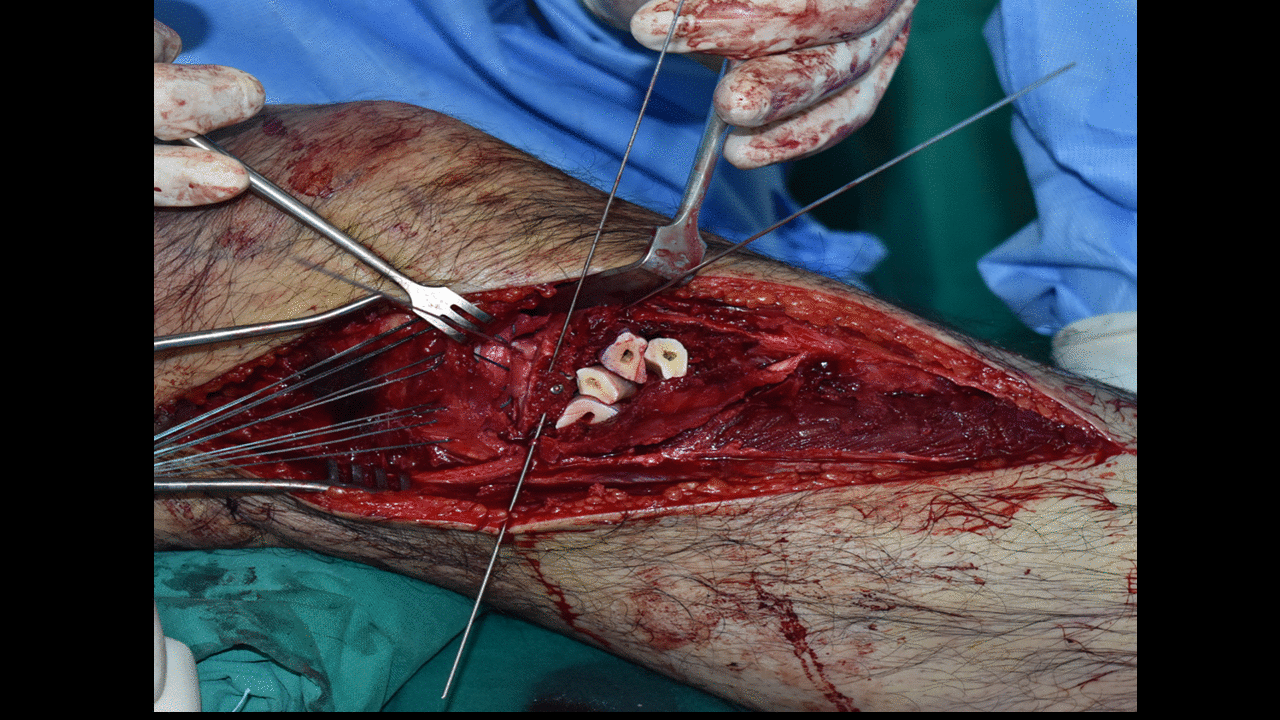 | |
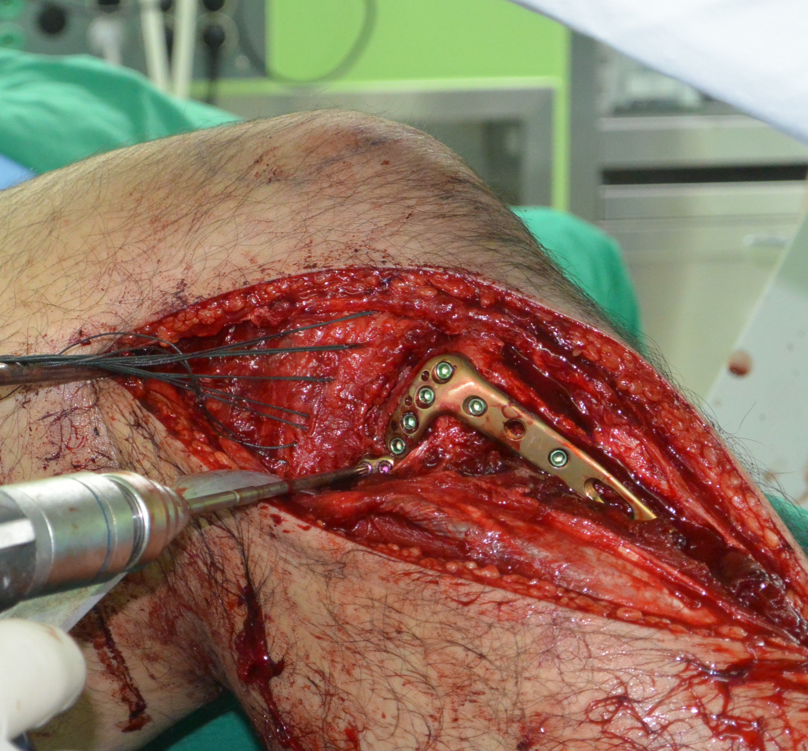 |
 |
References
- ↑ Papagelopoulos PJ, Partsinevelos AA, Themistocleous GS, Mavrogenis AF, Korres DS, Soucacos PN (2006). "Complications after tibia plateau fracture surgery". Injury. 37 (6): 475–84. doi:10.1016/j.injury.2005.06.035. PMID 16118010.
- ↑ Schatzker J, McBroom R, Bruce D (1979). "The tibial plateau fracture. The Toronto experience 1968--1975". Clin Orthop Relat Res (138): 94–104. PMID 445923.
- ↑ Yoon RS, Liporace FA, Egol KA (2015). "Definitive fixation of tibial plateau fractures". Orthop Clin North Am. 46 (3): 363–75, x. doi:10.1016/j.ocl.2015.02.005. PMID 26043050.
- ↑ McNamara IR, Smith TO, Shepherd KL, Clark AB, Nielsen DM, Donell S, Hing CB (2015) Surgical fxation methods for tibial plateau fractures. Cochrane Database Syst Rev. 9:CD009679
- ↑ Khatri K, Sharma V, Goyal D, Farooque K (2016) Complications in the management of closed high-energy proximal tibial plateau fractures. J Traumatol 19(6):342–347
- ↑ Johnson EE, Timon S, Osuji C (2013) Surgical technique: Tscherne-Johnson extensile approach for tibial plateau fractures. Clin Orthop Relat Res. 471(9):2760–2767
- ↑ Solomon LB, Stevenson AW, Lee YC, Baird RP, Howie DW (2013) Posterolateral and anterolateral approaches to unicondylar posterolateral tibial plateau fractures: a comparative study. Injury 44(11):1561–1568
- ↑ Yu B, Han K, Zhan C, Zhang C, Ma H, Su J (2010) Fibular head osteotomy: a new approach for the treatment of lateral or posterolateral tibial plateau fractures. Knee 17(5):313–318
- ↑ Robertson GAJ, Wong SJ, Wood AM (2017) Return to sport following tibial plateau fractures: a systematic review. World J Orthop 8(7):574–587
- ↑ Caspari RB, Hutton PM, Whipple TL, Meyers JF (1985) The role of arthroscopy in the management of tibial plateau fractures. Arthroscopy 1985(1):76–82
- ↑ Jentzsch T, Fritz Y, Veit-Haibach P, Schmitt J, Sprengel K, Werner CM (2015) Osseous vitality in single photon emission computed tomography/computed tomography (SPECT/CT) after balloon tibioplasty of the tibial plateau: a case series. BMC Med Imaging 15:56
- ↑ Softness KA, Murray RS, Evans BG (2017) Total knee arthroplasty and fractures of the tibial plateau. World J Orthop 8(2):107–114
- ↑ *Coronal bicondylar tibial plateau fracture involving the posterior condyles has also been seen.
Approach
- When these fractures has a coronal component, the buttress plate is placed from behind using a posteromedial approach.<ref>Moore TM (1981) Fracture-dislocation of the knee. Clin Orthop Relat Res 156:128–140
- ↑ Khatri K, Sharma V, Goyal D, Farooque K (2016) Complications in the management of closed high-energy proximal tibial plateau fractures. J Traumatol 19(6):342–347
- ↑ Maroto MD, Scolaro JA, Henley MB, Dunbar RP (2013) Management and incidence of tibial tubercle fractures in bicondylar fractures of the tibial plateau. Bone Joint J 95-B(12):1697–1702
- ↑ Keightley AJ, Nawaz SZ, Jacob JT, Unnithan A, Elliott DS, Khaleel A (2015) Ilizarov management of Schatzker IV to VI fractures of the tibial plateau: 105 fractures at a mean follow-up of 7.8 years. Bone Joint J 97-B(12):1693–1697
- ↑ Rossi R, Bonasia DE, Blonna D, Assom M, Castoldi F (2008). "Prospective follow-up of a simple arthroscopic-assisted technique for lateral tibial plateau fractures: results at 5 years". Knee. 15 (5): 378–83. doi:10.1016/j.knee.2008.04.001. PMID 18571417.
- ↑ Berkson EM, Virkus WW (2006) High-energy tibial plateau fractures. J Am Acad Orthop Surg 14(1):20–31
- ↑ Softness KA, Murray RS, Evans BG (2017) Total knee arthroplasty and fractures of the tibial plateau. World J Orthop 8(2):107–114